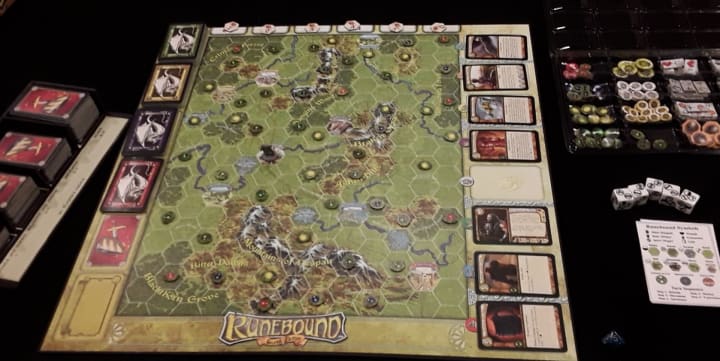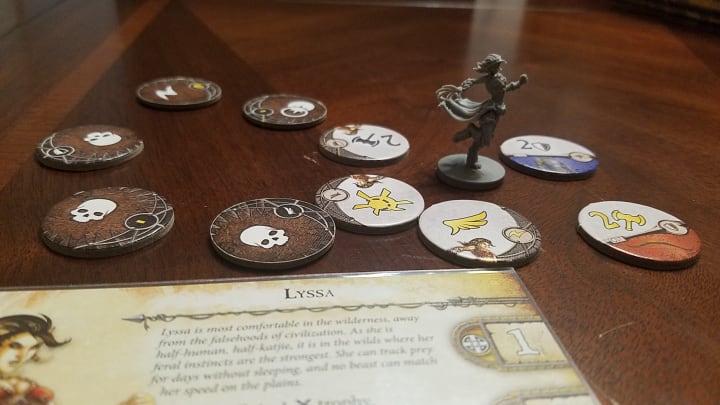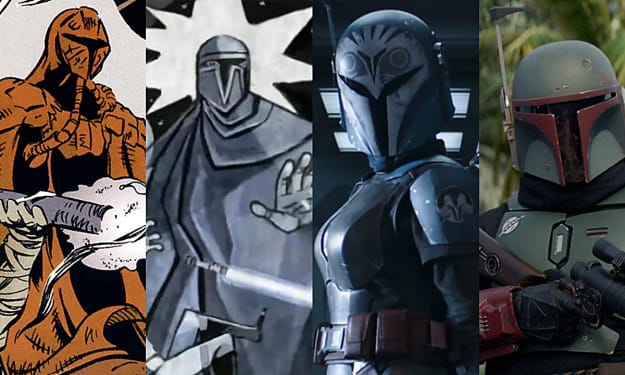'Runebound' to Adventure
Crossing Between Second and Third Edition

Adventure board games should be like a favorite movie, book, or video game, and keep you invested in every choice a hero makes as they become stronger. In Runebound Second Edition (2005), and Third Edition (2015) you start as an insignificant character with few skills, no weapons, and a heavy quest to become mighty enough to pluck the evils from the lands of Terrinoth. Each edition handles this rise of power differently, and feels like how my life as a gamer has changed.

Helpful items
In this comparison, for Second Edition I used a house rule for the equipment deck and divided it into four stacks: weapons, artifacts, rituals, and armor. This was done because with the expansions, one sole stack would reach the moon and timber with a hint of a breeze.
I ran Second Edition with the doom track variant, which allowed for only 16 adventure counters to be challenged. The Third Edition already has a timed track of 24 turns. These countdowns make every move, and encounter a tactical choice as time ticks urgently into the end game. Playing solo or with others, I don’t have time to play hours upon hours without a fast-paced end game in sight—dullness would set in, and my toddler has demands.

2nd or 3rd comparing sizes.
For adventure, I plugged in “Rise of the Dragon Lords” for second and “The Ascendance of Margath” for third. In both, fire rises as the Dragon Lord Margath returns to burn the world down. Both games setup similarly by placing different colored gems in multiple locations, which relate to challenge decks in waiting.
Many of the challenges are combat related, and both games have different systems.

Second Edition's beauty shot
In Second, if you don’t flee, there is a three-part combat round where you attack once and defend twice. It’s as easy as rolling two ten-sided dice and adding them up with your skill and weapon bonuses. Your allies can attack in a round you don’t. If any rolls miss the opponent’s value, damage is given. A hero could possibly take damage three times in a round.
This is total Ameritrash gaming with the chaotic throw of the dice determining your fate. I loved this style from way back in my Hero Quest days and still embrace this style of gaming in games like Descent:Journeys in the Dark edition, and X-Wing. Here, it feels redundant, rolling four times an attack round, with three of those rolls trying not to be hit.
My sadistic nature loves having an ally attack in a phase you have a slim chance to hit or defend, only to have them be hit when they miss. I call it “Operation Decoy Sacrifice,” or “Push Ally in Death’s Way.”

3rd Edition's beauty shot
Third Edition has both hero and monster cast combat tokens, which players must strategize and manipulate to maximize their damage and defensive properties. Each disk has a different symbol on each side, and as you collect additional equipment, the more you can toss and manipulate. Both parties go back and forth resolving disks of the same type until they’re spent. Then the next round continues until one of you is victorious.
It’s a sad thing in third that there are no ally decoys to sacrifice.
In both, there is a thrill to see where dice and the combat tokens land. I love the tactical nature of the tokens, and how it allows me the illusion of more control in battle. Acquiring more of them gives a sense of power and accomplishment, and even if some of the equipment gained is less than stellar, I feel I can make it beneficial. With this type of engine, every step, even the tiniest ones, feels forward, and is what I mostly enjoy now.

Combat is reining disks.
Actions per turn play differently for both editions. In second, your actions are set in stone to movement first, and then adventure/market (if you land on an appropriate space) second.
In third, you have three actions. They are what you make of them, in whatever order you want, and how many times you want them. You could move three times to quickly travel the country. You could gain a quest, move, and try to complete it if you have a stored action. Attempt to shop three times in town to look for the perfect weapon, armor, or equipment. These freeform options in an adventure game help a hero come into their own.

Progressing into greatness in 2nd edition.
Upgrading your character is fun in both editions. The sheer variety each has means you may have a slim chance to find the holy grail of weapons you’re looking for. Where the upgrades differ are in stats vs skills. In second edition, it's about pimping out your stats two points at a time, and helping your rolls add up to higher numbers.
In third, the skills you gain might raise a stat, or make you better at things such as movement, gaining experience cards, or making you mightier in battle. I like both systems. In third, how one sets up the skill deck might mean whether you find a favorite skill tucked in there or not. This adds to the sense of discovery, and changes the dynamics of the game in a small way.

Don't underestimate my humble beginnings.
After the game is over, I usually draw, and take on a random beginning encounter to see how far my hero has evolved. By seeing my swiftness in dispatching the enemy, I am reminded of how mighty my hero has become.
The rise of power in both Runebound editions is a harsh voyage where global events, and vicious monsters are ready to tear you up. When the fatal blow is placed into the heart of the Dragon Lord, and the sense of fulfillment hits, you realize how unstoppable you've become. The parades in your honor happen in every Terrinoth city, town, and monastery.
As I breakdown the games, both nostalgic and renewed feelings wash over me like sunlight. The memories of playing second with no thought of how time has passed, but feeling how each turn took so long when it wasn't mine. In third, I can complete an epic adventure before my toddler wakes from a nap, and I become a parent again. Though they have become solo games, the sentimental nature keeps Second Edition on my shelf, but the tactical and fresh side of third brings it to the table. In both, I have not yet explored all they have to offer, but I am willing to sacrifice time for a hero's journey.
About the Creator
Wade A. Stewart
I'm a writer of many unpublished works, movie watcher, lover of art, and board game player.
Twitter: @allenkwest






Comments
There are no comments for this story
Be the first to respond and start the conversation.